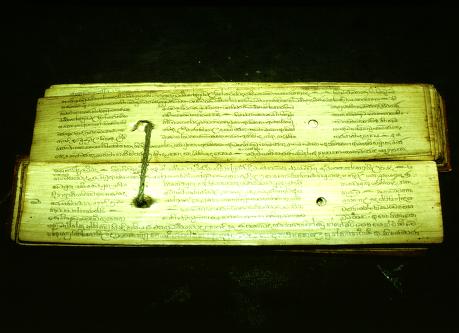 වසර 2500 ක සිංහල ශිෂ්ටාචාරය පිළිබඳ තබා ඇති හොඳම සටහන ලෙස සැලකෙන්නේ ධාතුසේන රජුගේ බෑණා කෙනකු වූ මහනාම හිමියන් විසින් අනුරාධපුර සමයේදී ලියූ මහාවංශයයි.
වසර 2500 ක සිංහල ශිෂ්ටාචාරය පිළිබඳ තබා ඇති හොඳම සටහන ලෙස සැලකෙන්නේ ධාතුසේන රජුගේ බෑණා කෙනකු වූ මහනාම හිමියන් විසින් අනුරාධපුර සමයේදී ලියූ මහාවංශයයි. එය කොටස් තුනකින් යුක්ත වන අතර ක්රි.ව. 543 විජය කුමාරයාගේ පැමිණීමේ සිට 1815 ඉංග්රීසීන් විසින් ලංකාව අල්ලා ගන්නා තෙක් ලියවී ඇත. එය කොටස් තුනකින් යුක්ත වන අතර විවිධ කාල වලදී ලියවී ඇත.
Sri Lanka has a long historical recorded in the chronicle known as the Mahavamsa meaning the "Great Chronicle". It is the single most important work of Sri Lankan origins. It describes the life and times of the people who forged our nation, from the coming of Vijaya in 543 BC to the final takeover by the British in 1815. The Mahavamsa itself is actually comprised of three parts, all written at different times in Lankan history.
The first part was written in the 6th century AD by King Dhatusena's brother, the venerable thera Mahanama. His work was greatly influenced by the Dipavamsa written five centuries earlier. It describes the foundation of the Lankan monarchy with the consecration of King Vijaya and continues to the end of King Mahasena's rule in the 4th century AD. The second part of the Mahavamsa, more commonly known as the Culavamsa was written in the 13th century AD. This chronicles the time between the arrival of the Tooth Relic in the 4th century AD and the end of the reign of King Parakramabahu the Great. Credit for this part is given to the thero Dhammakitti, but many historians believed that it was authored by many monks. The third and final part was written over many years, concluding in the year 1815, when the British occupied the whole of Lanka by military force.
The official translation of the Mahavamsa from Pali was completed by Wilhelm Geiger in 1912 and subsequently the Culavamsa in 1930. The first English translation of the Mahavamsa from Mr. Geiger's native German was done by Mrs. Mabel Haynes Bode. Overall, the Chronicle has over 200,000 words of text in about 960 printed pages. It is as I mentioned earlier divided into three parts. Mr.Geiger called the first part (Chapters 1-37) the Mahavamsa, the second part (Chapters 38-79) the Culavamsa I, and the third and final part (Chapters 80-101) the Culavamsa II.
The first part was written in the 6th century AD by King Dhatusena's brother, the venerable thera Mahanama. His work was greatly influenced by the Dipavamsa written five centuries earlier. It describes the foundation of the Lankan monarchy with the consecration of King Vijaya and continues to the end of King Mahasena's rule in the 4th century AD. The second part of the Mahavamsa, more commonly known as the Culavamsa was written in the 13th century AD. This chronicles the time between the arrival of the Tooth Relic in the 4th century AD and the end of the reign of King Parakramabahu the Great. Credit for this part is given to the thero Dhammakitti, but many historians believed that it was authored by many monks. The third and final part was written over many years, concluding in the year 1815, when the British occupied the whole of Lanka by military force.
The official translation of the Mahavamsa from Pali was completed by Wilhelm Geiger in 1912 and subsequently the Culavamsa in 1930. The first English translation of the Mahavamsa from Mr. Geiger's native German was done by Mrs. Mabel Haynes Bode. Overall, the Chronicle has over 200,000 words of text in about 960 printed pages. It is as I mentioned earlier divided into three parts. Mr.Geiger called the first part (Chapters 1-37) the Mahavamsa, the second part (Chapters 38-79) the Culavamsa I, and the third and final part (Chapters 80-101) the Culavamsa II.
 ශිල්ප 64
ශිල්ප 64